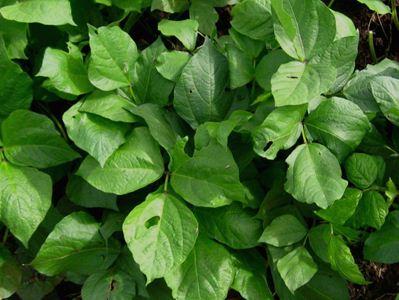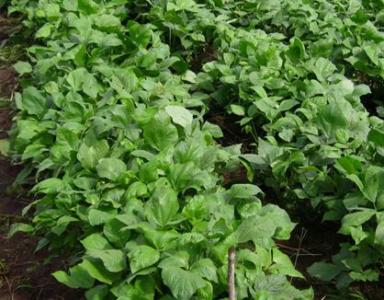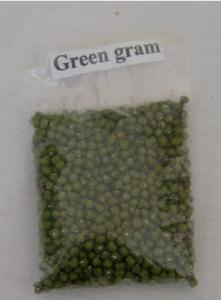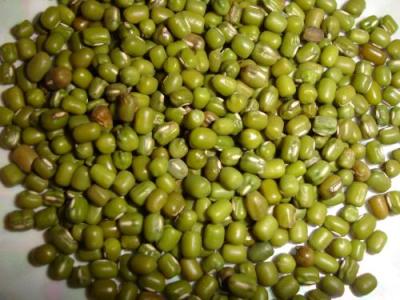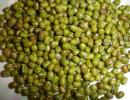
|
Green gram
Scientific name:
Vigna radiata
Order/Family:
Fabales: Fabaceae
Local names:
Pojo (Swahili)
Common names:
Mungbean
Pests and Diseases:
African bollworm
Anthracnose
Aphids
Bacterial blight
Bean flies
Bugs
Cowpea seed beetle
Damping-off diseases
Foliage beetles
Powdery mildew
Rust
Storage pests
Thrips
Whiteflies
Yellow mosaic virus
|
Pod-borers (African bollworm, Legume pod-borer, lima pod borer)
Pod borers such as the African bollworm (Helicoverpa armiguera), the legume pod borer (Maruca vitrata), and the lima bean pod borer (Etiella zinckenella) can cause serious economic damage. Young caterpillars of the African bollworm feed on leaves by scraping tissue for short time, and then bore into the pods and feed on the seeds with their heads thrust inside and most part of the body outside. The entry hole is large and circular. They also cause significant damage to flower buds and flowers.
Caterpillars of the legume pod borer (Maruca vitrata) are dull to yellow-white and often reach a length of 18 mm. Each segment has dark spots that form a distinct series along the length of the body. The head is dark brown to black. Caterpillars web together leaves, buds and pods and feed inside the web. Flowers attacked may be discoloured and have damaged or missing reproductive parts. Damage by this caterpillar also results in flower bud shedding and reduced pod production. Damaged pods have small, darkened entry holes on the surface.
Young caterpillars of the lima bean pod borer are green, later turning red. They feed inside the pod reaching a length of 14 mm. They are generally found in maturing and dried pods. Faeces in the form of granules are found inside the damaging pods.
Once the caterpillars have entered the pods they are difficult to control and by then they have already caused damage.
- Monitor the crops frequently as there is only a brief period from hatching to entering buds or pods.
- Hand pick and destroy eggs and caterpillars. This helps when their numbers are low and in small fields.
- Biopesticides such as Bt or neem products usually give good control of pod borers, provided they are applied to the young caterpillars before they enter into the pods. For more information on neem click here. For information on Bt click here
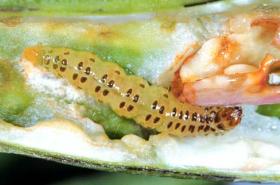
© Ooi P. Courtesy of EcoPort, www.ecoport.org

Legume pod…

African bo…

African bo…
Anthracnose (Colletotrichum lindemuthanium)
It attacks all above ground parts of the plant. It does most serious damage on pods. Affected pods have brownish sunken spots, which under humid conditions are covered with a pink spore mass. Infected seeds become discoloured (brownish black).
- Plant certified disease-free seeds.
- Plant resistant varieties, where available.
- Practise crop rotation with non-legumes such as cereals.
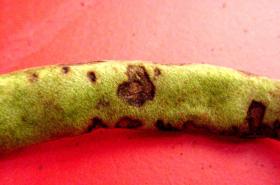
© A.M. Varela, icipe
Aphids
Aphids, mainly the legume aphid (Aphis craccivora) (also called groundnut aphid) are relative small. Immatures are slightly dusted with wax, adults without wax. Apterae are 1.4 to 2.2 mm long. Alatae (winged form) 1.4 to 2.1 mm. They feed on young plants, leaflets, stem and pods of green gram. Attacked young leaves become twisted. Excretion of honeydew leads to growth of sooty mould. Aphids are also vectors of virus diseases.
- Plant early.
- Cultivate thorough to ensure weed-free plots. .
- Avoid excess use of nitrogen.
- Conserve natural enemies.

© James Litsinger. Reproduced from the Crop Protection Compendium, 2004 Edition. © CAB International, Wallingford, UK, 2004
Bacterial blight (bean blight) (Xanthomonas pv. phaseoli)
Leaf spots first appear as small, water-soaked or light-green areas on leaflets. They later become dry and brown. The spots may join to affect much of leaf surface eventually killing the leaflet. Similar water-soaked spots develop on pods. The spot margin is a shade of red. Severely diseased pods shrivel. In humid weather, a yellowish crust of the blight bacteria covers the spot surface.
- Cultural practices are important in controlling bean blights. Eliminate weeds, volunteer beans and other potential hosts of bean blight, as this will reduce disease incidence.
- Good weed control will also improve aeration around the crop so that the plants dry faster, this will reduce the chances for bacterial spread and infection.
- The bacteria are readily spread by water, and walking or working in the field while plants are wet will splash the bacteria and create wounds. Therefore avoid field operations when it is wet.
- A rotation of at least 2 years between bean crops will give time for the bacteria population to decline in the debris.
- Deep ploughing will also encourage the breakdown of infected plant debris.
- The incidence of bean blight can also be reduced if beans are grown with maize rather than in a monoculture.
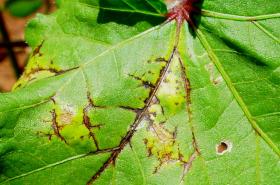
© A.A. Seif & A.M. Varela, icipe

Bacterial …

Bacterial …
Bean flies (Ophiomyia phaseoli and related species)
Bean flies are tiny about 2mm long, shiny black-bluish in colour. They can cause serious stand reductions at the seedling stage. Bean flies lay eggs in punctures of leaves near the petiole. The small white maggots feed inside the main stem just above the soil line. Pupation occurs inside the stem. The life cycle may be completed rapidly, often in less than 2 weeks.
Seedlings attacked by bean flies may wilt or die. Leaves of older plants may be yellow and stunted. Stems are thicker than normal and cracked lengthwise just above the soil. Maggot feeding facilitates the entry of disease-causing microorganisms leading to secondary infections. In cases of heavy infestation, many plants die. Bean flies are important only during the seedling stage (up to 4 weeks after germination).
- Plant early in the season. Bean fly numbers tend to be low during the early stages of the growing season and increase with time.
- Plant after green manure crop.
- Avoid planting near cowpea, beans and other leguminous crops, that may be the source of bean flies.
- Practise crop rotation with non-legumes such cereals.
- Ridging the plants 2-3 weeks after germination helps to cover the adventitious roots produced by plants damaged by bean flies (these roots grow directly from stems and/or leaves). The soil support prevents lodging and improves the survival of the damaged plants.
- Mulch with rice straw. The mulch covers the seed leaves (cotyledons) making them inaccessible for egg laying.
- If necessary, spray neem extracts. Frequent foliar applications of neem extract give satisfactory control of bean flies.
- Remove and destroy crop residues and all plant parts with symptoms of damage by bean flies.

© A.M. Varela, icipe

Bean fly

Bean fly
Pod sucking bugs
Pod sucking bugs such as giant coreid bugs (Anoplocnemis curvipes), spiny brown bugs (Clavigralla spp.), green stink bugs (Nezara viridula, Acrosternum acutum), and Riptortus bugs (Riptortus spp) are the most important pests of green gram at the podding stage.
They suck sap from pods and seeds and cause various levels of damage depending on the stage of growth of seeds at the time of attack. Feeding may cause necrosis, pod malformation, premature drying, shrivelling of seeds, loss of germination ability, and formation of empty pods. Bugs are difficult to control since they usually feed on a wide range of crops and are very mobile.
- Bugs can be collected by hand regularly and killed, especially during flowering and pod formation.
- Conserve natural enemies such as assassin bugs, spiders, praying mantises and ants. These are important natural enemies of bugs. They kill or deter bugs. Conserve and attract predatory natural enemies to your crop by planting flowering plants. For more information on natural enemies click here
- Neem products are reported to repel bugs. If necessary, spraying should be done in the morning when the immature stages are exposed.
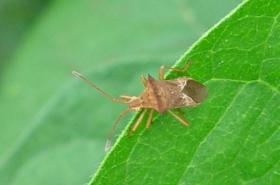
© A.M. Varela, icipe

Spiny brow…

Tip wilter

Green stin…

Riptortus …
The cowpea weevil (Callosobruchus maculatus)
Cowpea bruchids (Callosobruchus spp.) are the most common and widespread insect pests in storage. Adults are 2 to 3.5 mm long. They are major pests of pulses (cowpeas, pigeon peas, soybean, green gram and lentils). They attack both pods in the field and seeds in storage. They attack nearly mature and dry pods. Infested stored seeds can be recognised by the round exit holes and the white eggs on the seed surface. Post-harvest losses are highly variable, but losses can be over 90%.
It is a serious storage insect, which can destroy whole seed-lots.
- Dry grains to moisture level below 13%.
- Store grains in dry, well ventilated areas.
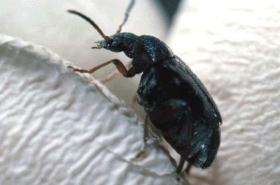
© Peter Credland. Reproduced from the Crop Protection Compendium, 2006 Edition.

Cowpea see…

Pupa of th…
Damping-off diseases (Pythium spp., Fusarium spp., Rhizoctonia solani)
They are caused by a complex of fungi. They cause rotting of seeds before emergence and seedlings after emergence from the soil. Affected fields appear patchy. They are favoured by wet, cool weather.
- Use certified disease-free seeds.
- Practise proper irrigation.
- Treat seeds with hot-water, if necessary. For more information on hot-water seed treatment click here.
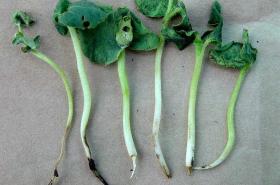
© A.A. Seif & A.M. Varela, icipe

Damping-of…

Damping-of…
Foliage beetles (Ootheca spp.)
Foliage beetles have been reported as pests of green grams in West Africa. They are a threat, when present in large numbers since they can defoliate young plants. They are 4-7mm long.
- Practise post harvest tillage to expose the grubs in the soil to the sun and to predators.
- Rotate grams with non-host plants such as maize or sunflower to break the development cycle of the pest.
- Delay sowing, where practicable, to allow the crop to escape from high populations.
- Apply neem; it has been shown to reduce flea beetle numbers and damage.
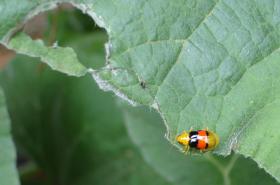
© A.M. Varela, icipe

Foliage be…

Foliage be…
Powdery mildew (Erysiphe polygoni)
White powdery patches appear on leaves and other green parts, which later become dull coloured. These patches gradually increase in size and become circular covering the lower surface. When the infection is severe, both the surfaces of the leaves are completely covered by whitish powdery growth. Severely affected parts get shrivelled and distorted. In severe infections, foliage becomes yellow causing premature defoliation. The disease also creates forced maturity of the infected plants which results in heavy yield losses. The fungal agent (pathogen) has a wide host range and survives on various hosts in off-season. It is spread by wind and water splash.
- Plant resistant varieties.
- Plant early.
- Remove weeds.
- Practise a good field sanitation.
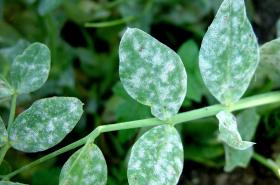
© A.M. Varela
Rust (Uromyces phaseoli)
The disease appears as circular reddish brown pustules (blisters) which appear more commonly on the underside of the leaves, less abundant on pods and sparingly on stems. When leaves are severely infected, both the surfaces are fully covered by rust pustules. Shrivelling of pods is followed by defoliation resulting in yield losses. Long distance spread of rust is by wind. Plant to plant spread is by farm tools, and moving bodies within the crop.
- Plant resistant varieties, if available.
- Avoid continuous cropping with legumes.
- Practise crop rotation with non-legumes such as cereals.
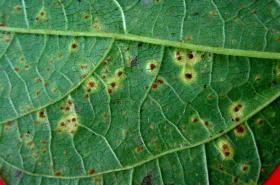
© A. M. Varela, icipe
Flower thrips (Megalurothrips sjostedti)
It may feed on petioles and leaves, but prefer flowers. Attacked petioles and leaves have tiny holes surrounded by discoloured areas. Affected flowers are brown, dry or completely distorted. The flowers drop prematurely. Thrips also feed on pollen leading to decrease in pollination and seed set. Pod production is low and pods are deformed.
- Plough and harrow before planting. It can reduce subsequent thrips attacks by killing pupae in the soil.
- Conserve natural enemies. Natural enemies, particularly, predators are important in natural control of thrips. Main natural enemies include predatory bugs (Orius spp. and Anthocoris spp.) and predatory thrips.
- Spray with biopesticides (e.g. Spinosad), if infestation is severe.
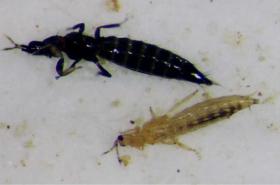
© GTZ-IPM Horticulture, Kenya

Thrips

Thrips
Whiteflies (Bemisia tabaci, Aleurodicus dispersus)
Several species of whiteflies are found on cassava in Africa. Feeding causes direct damage, which may cause considerable reduction in root yield if prolonged feeding occurs. Some whiteflies cause major damage to cassava as vectors of cassava viruses. The spiralling whitefly (Aleurodicus dispersus) was reported as a new pest of cassava in West Africa in the early 90s.
The adults and nymphs of this whitefly occur in large numbers on the lower surfaces of leaves covered with large amount of white waxy material. Females lay eggs on the lower leaf surface in spiral patterns (like fingerprints) of white material secreted by the female. This whitefly sucks sap from cassava leaves. It excretes large amounts of honeydew, which supports the growth of black sooty mould on the plant, causing premature fall of older leaves.
The tobacco whitefly (Bemisia tabaci) transmits the African cassava mosaic virus, one of the most important factors limiting production in Africa. The adults and nymphs of the tobacco whitefly occur on the lower surface of young leaves. They are not covered with white material. The nymphs appear as pale yellow oval specks to the naked eye.
- Conserve natural enemies. Parasitic wasps in particular are very important for natural control of whiteflies. For instance Encarsia formosa, natural enemy of the tobacco whitefly, and Encarsia haitiensis a natural enemy of the spiralling whitefly (Neuenschwander, 1998; James, et al, 2000).
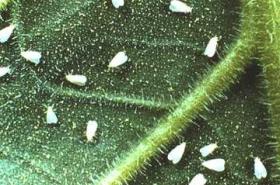
© Clemson University, Department of Entomology
Mungbean yellow mosaic virus (MYMV)
MYMV causes serious loss in pulse crops such as beans, pigeonpea, mungbean and soybean. It is transmitted by the whiteflies, (Bemisia tabaci).
Symptoms: initially mild scattered yellow spots appear on young leaves. The spots gradually increase in size and ultimately some leaves turn completely yellow. Infected leaves also show necrotic symptoms. Diseased plants are stunted, mature late and produce very few flowers and pods. Pods of infected plants are reduced in size and turn yellow in colour.
The virus is not seed transmitted in mungbean or soybean.
- Plant tolerant/resistant varieties where available
- Plant early and weed properly.
- Control the vector (whiteflies).
| General Information and Agronomic Aspects | Information Source Links | |||
| Information on Diseases | Contact links | |||
| Information on Pests |
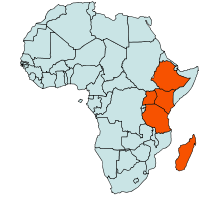 |
| Geographical Distribution of Green gram in Africa |
Nutritive Value per 100 g of edible Portion
| Raw or Cooked Green Gram | Food Energy (Calories / %Daily Value*) |
Carbohydrates (g / %DV) |
Fat (g / %DV) |
Protein (g / %DV) |
Calcium (g / %DV) |
Phosphorus (mg / %DV) |
Iron (mg / %DV) |
Potassium (mg / %DV) |
Vitamin A (I.U) |
Vitamin C (I.U) |
Vitamin B 6 (I.U) |
Vitamin B 12 (I.U) |
Thiamine (mg / %DV) |
Riboflavin (mg / %DV) |
Ash (g / %DV) |
| Green Gram cooked | 105 / 5% | 19.2 / 6% | 0.4 / 1% | 7.0 / 14% | 27.0 / 3% | 99.0 / 10% | 1.4 / 8% | 266 / 8% | 24.0 IU / 0% | 1.0 / 2% | 0.1 / 3% | 0.0 / 0% | 0.2 / 11% | 0.1 / 4% | 0.8 |
| Green Gram raw | 347 / 17% | 62.6 / 21% | 1.2 / 2% | 23.9 / 48% | 132.0 / 13% | 367 / 37% | 6.7 / 37% | 1246 / 36% | 114 IU / 2% | 4.8 / 8% | 0.4 / 19% | 0.0 / 0% | 0.6 / 41% | 0.2 / 14% | 3.3 |
| Green Gram sprouted raw | 30.0 / 2% | 5.9 / 2% | 0.2 / 0% | 3.0 / 6% | 13.0 / 1% | 54.0 / 5% | 0.9 / 5% | 149 / 4% | 21.0 IU / 0% | 13.2 / 22% | 0.1 / 4% | 0.0 / 0% | 0.1 / 6% | 0.1 / 7% | 0.4 |
Land should be prepared to a medium tilth before planting and early enough so that planting can start immediately after the rain starts. When using oxen plough for planting, place the seed at the side of the furrow.
Propagation is by seed. There is no seed dormancy. Seeds may sprout in the pod under very humid conditions. In areas with higher rainfall, it is recommended to grow green grams on raised beds. Prepare the beds, raised about 20 cm and spaced 1 m from the centre of one bed to the centre of the next. Sow seeds on raised beds in two rows per bed, spaced 45 cm apart.
Green grams will respond to fertiliser or manure application but will normally give satisfactory results if grown on relatively good soil.
Green gram is grown mainly on smallholdings, often as mixed crops or intercrops. Associated crops are usually of longer duration than green gram (sugar-cane, cotton, sorghum). To make use of a short cropping period, short-duration green gram is often relay-cropped.
| Variety | Maturity Days | Potential yield t/ha | Remarks |
| "KVR 22" ("N 22") | 80-90 | 1.0-1.3 |
|
| "KVR 26" (N 26) | 60-65 | 0.3-1.5 |
|
|
|
|
Examples of green grams varieties grown in Tanzania
- "Nuru" (performs well between 0 and 1350 m above sea level; days to flowering: 50; yield potential: 1.5 t/ha; resistant to mosaic disease; moderately resistant to bacterial blight)
- "Imara" (grows well between 0 and 1350 m above sea level; days to flowering: 50; yield potential: 1.5 t/ha; resistant to mosaic disease; moderately resistant to bacterial blight; it has wide adaptability)
Examples of green gram varieties grown in Uganda
- "N 26" (characteristics as in Kenya)
- "N 22" (characteristics as in Kenya)
Grams planted at the end of the long rains are normally intercropped into other major crop. In Meru, Kenya, green gram is a preferred intercrop for millet, each said to protect the other against diseases and pests. If grams are intercropped with maize, the maize spacing is the same as in pure stand, but the grams are interplanted mid-way between the maize rows.
Early weeding is recommended. First weeding should be done just after emergence and second weeding just before flowering.
|
Damping-off diseases (Pythium spp., Fusarium spp., Rhizoctonia solani) They are caused by a complex of fungi. They cause rotting of seeds before emergence and seedlings after emergence from the soil. Affected fields appear patchy. They are favoured by wet, cool weather. | 
Damping-off disease
Okra seedlings affected by damping-off © A.A. Seif & A.M. Varela, icipe |
|
What to do:
|
|
Mungbean yellow mosaic virus (MYMV) MYMV causes serious loss in pulse crops such as beans, pigeonpea, mungbean and soybean. It is transmitted by the whiteflies, (Bemisia tabaci). |
|
|
What to do:
|
|
Pod-borers (African bollworm, Legume pod-borer, lima pod borer) Pod borers such as the African bollworm (Helicoverpa armiguera), the legume pod borer (Maruca vitrata), and the lima bean pod borer (Etiella zinckenella) can cause serious economic damage. Young caterpillars of the African bollworm feed on leaves by scraping tissue for short time, and then bore into the pods and feed on the seeds with their heads thrust inside and most part of the body outside. The entry hole is large and circular. They also cause significant damage to flower buds and flowers.
| 
Legume pod borer
Legume pod borer (Maruca vitrata) reach a length of 18 mm © Ooi P. Courtesy of EcoPort, www.ecoport.org |
|
What to do:
|
|
Pod sucking bugs Pod sucking bugs such as giant coreid bugs (Anoplocnemis curvipes), spiny brown bugs (Clavigralla spp.), green stink bugs (Nezara viridula, Acrosternum acutum), and Riptortus bugs (Riptortus spp) are the most important pests of green gram at the podding stage. | 
Spiny brown bugs
Spiny brown bugs (Clavigralla spp.) measure about 1cm in length. © A.M. Varela, icipe |
|
What to do:
|
- AIC (2002). Field Crops Technical Handbook.
- Adamu, R. S., Dike, M. C., Akpa, A. D. (2001). Insect fauna associated with greengram (Vigna radiata (L.) Wilc.) in the Northern Guinea Savanna of Nigeria. Journal of Sustainable Agriculture and the Environment, (Vol. 3) (No. 2) 331-336.
- CAB International (2005). Crop Protection Compendium, 2005 edition. Wallingford, UK www.cabi.org
- From ECHO's seedbank. Green Gram or Mung Bean (Vigna radiata). By Bob Hargrave, ECHO Staff. http://www.echonet.org Available here: download
- Insect Pest Management in Moong. Integrated Pest Management. www.jnkvv.nic.in
- JNKVV, Madhya Pradesh, India: Diseases of green grams. www.jnkvv.nic.in
- Kenya Agricultural Research Institute. KARI. Improved Green Gram Production. www.kari.org
- Lost Crops of Africa: Volume II: Vegetables (2006) Development, Security, and Cooperation (DSC). Online read-only: The National Academy Press: www.nap.edu
- Nutrition Data www.nutritiondata.com.
- Post harvest profile of green gram. Government of India, Ministry of Agriculture (Department of Agriculture and Cooperation) Directorate of Marketing and inspection. Branch Head Office. Nagpur - 440001. MRPC-76. www.agmarknet.nic.in
- Publications and Fact Sheets on Mungbean. AVRDC Extension Materials. www.avrdc.org
- Meru Herbs Organic Farmers Kenya
P.O. Box 14343
00800 Nairobi
Kenya
Tel/Fax: + 254 20 4442081
Email: meruherbs@meruherbs.com
Website: www.meruherbs.com
Products: Organic produced chamomile, hibiscus, and fruits (bananas & mango).

 Back
Back
